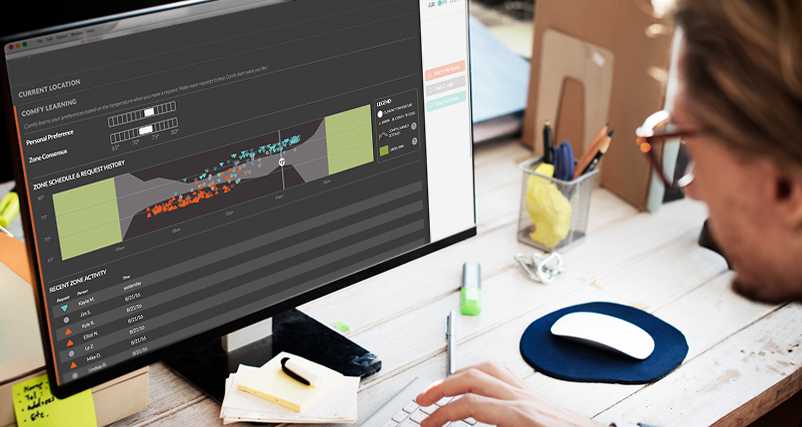As the number of Comfy users has continued to grow, we’ve been amassing what may be the largest dataset of feedback on thermal comfort ever collected, both in terms of quantity of observation points as well as the number of participants. What this data reveals will be eye-opening for anyone who has ever been impacted by workplace temperature settings. However, it is especially informative for those who design new buildings, who write building codes and standards, and who generally care about occupant comfort.
At this year's ACEEE Summer Study on Energy Efficiency in Buildings, we presented a paper, titled "Control for the People: How Machine Learning Enables Efficient HVAC Use Across Diverse Thermal Preferences," summarizing some of our preliminary observations. The purpose of the paper is to help architects, designers, engineers and policymakers in their pursuit to make all of our spaces more comfortable. Our hope is that with better data, we can provide insight that will propel the building industry as a whole towards improving the human experience indoors.
For this study, we selected 16 of the buildings we worked in throughout 2015 and analyzed tens of thousands of data points collected from real, anonymized Comfy users all around the world. Here is what we learned.
1. Most people want it warmer on Monday mornings.

When we looked at Comfy usage patterns across all 16 sites, there was a clear and significant spike in "Warm My Space" requests made on Monday mornings. One of the reasons why this may be occurring is that most HVAC systems are like a lot like us on Monday mornings—still getting in work mode! In order to prep the building for occupants, many building operators schedule “ramp up” periods roughly two hours before the start of business hours. However, as you can imagine, it’s pretty easy to overshoot, for instance by cranking the air-conditioning too high on summer mornings, or to under-shoot by starting boilers too late during the winter—leading to freezing conditions on Monday morning. There may be other contributing psychological and/or physiological causes, but that's a research project for another day!
2. The desire for warmer or cooler air is more common in office areas (including open office layouts) than in conference rooms.

No surprise here. In general, people are at their desks for longer stretches of time than they are in specific conference rooms, making them more likely to reach a level of discomfort that warrants some relief. What’s also worth noting here is the obvious decrease in the number of requests made as people leave their desks for lunch breaks. Likewise, there are more requests made in conference rooms in the middle of the day, when more conference rooms are more likely to be occupied with meetings.
3. In conference rooms, cool air is the big need.

The vast majority of requests made in conference rooms are “Cool My Space” requests. This supports a common experience: conference rooms tend to feel stuffy as a direct result of several warm blooded people piling into an enclosed space for an extended period of time. Interestingly enough, it may be that people are really just requesting fresh air, not even cool air.
4. So-called "outliers" are more common than you'd think.

Everyone seems to have "that one" person in their office who is never satisfied with the temperature in the space. The reality is, our preferences as individuals are both diverse and dynamic. Aggregated data from Comfy shows that even when the thermostat reads 75ºF, there's still a 17% chance that some people will find it too cold. On the other end of the temperature spectrum, at 69ºF, there's still a 16% chance that people will find it too hot. Traditionally, we would label these moments as pretty crazy—who thinks 76 degrees is too cold?!
In a typical office, it is not uncommon for the temperature in an entire building to be set to 70-73℉ all the time, in an honest attempt to make the most people possible comfortable and content. In reality, our temperature preferences are much more nuanced than that. Whether you’re blessed with a high metabolic rate, happen to be sitting right next to a heater, or sporting a super sharp summer outfit—there are a lot of factors affecting comfort that aren’t captured by a thermostat.
At Comfy, we have just started scratching the surface of what our user data can tell us about personal comfort and the building industry at large. But from what we’ve seen so far, one message is loud and clear: one size fits none. By allowing dynamic and granular control, we’re starting to see just how varied people’s preferences are, and how ineffectual the traditional—and frankly, arbitrary—thermostat settings have been in meeting people’s needs at work. We look forward to sharing more data in the future and changing the way the entire industry approaches comfort in the office.

 Request a Demo
Request a Demo






